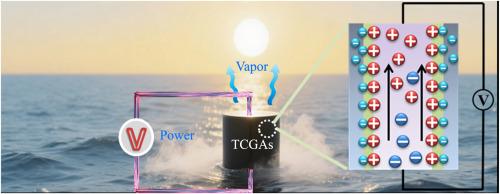用于同时发电和蒸汽热电联产的TiVCTX/碳纳米管/石墨烯气凝胶
IF 6.3
2区 材料科学
Q2 ENERGY & FUELS
引用次数: 0
摘要
持续的全球能源和水资源短缺危机刺激了多功能材料的创新,这些材料集成了清洁能源发电和海水淡化技术。本研究介绍了TiVCTX MXene/碳纳米管/石墨烯气凝胶(TCGAs),这是一种开创性的复合材料,用于并发水力发电和太阳能驱动的蒸汽发电。通过水热和冷冻干燥方法成功制备的TCGAs具有多孔纳米结构、高比表面积、卓越的亲水性和卓越的太阳能吸收能力。当暴露在3.5 wt% NaCl溶液中1个太阳辐照度时,TCGAs输出电压为90 mV,电流为50 μA;在3个太阳的条件下,由于离子传输的改善和光热效应的增强,这个输出上升到160毫伏。电解质优化表明,LiCl溶液优于NaCl和CaCl2:当LiCl浓度为3.5 wt%时,TCGAs产生112 mV和63 μA,当LiCl浓度为10.0 wt%时,TCGAs产生230 mV,功率密度为4.4 μW cm−2。对于海水淡化,TCGAs在1个太阳下的海水蒸发速率为1.0 kg m−2 h−1(转换效率为61.5%),在3个太阳下增加到4.72 kg m−2 h−1(转换效率为73.4%)。值得注意的是,TCGAs在发电和脱盐方面都表现出了卓越的循环稳定性,以及卓越的耐盐性和自脱盐性能。这些发现将TCGAs定位为可持续能源-水热电联产系统的一个有希望的候选者,为能源缺乏和水资源短缺的相互关联的问题提供了一个实用的解决方案。本文章由计算机程序翻译,如有差异,请以英文原文为准。

TiVCTX/carbon nanotubes/graphene aerogels for simultaneous power and steam cogeneration
The ongoing global crisis regarding energy and water shortages has spurred the innovation of multifunctional materials that integrate clean energy generation and seawater desalination technologies. This research introduces TiVCTX MXene/carbon nanotubes/graphene aerogels (TCGAs), a groundbreaking composite engineered for concurrent hydrovoltaic energy production and solar-driven steam generation. Fabricated successfully through hydrothermal and freeze-drying methods, TCGAs feature a porous nanostructure, high specific surface area, remarkable hydrophilicity, and exceptional solar absorption capabilities. When exposed to 1-sun irradiance in a 3.5 wt% NaCl solution, TCGAs generate an output voltage of 90 mV and a current of 50 μA; this output rises to 160 mV under 3-sun conditions, due to improved ion transport and enhanced photothermal effects. Optimization of the electrolyte indicates that LiCl solution outperforms NaCl and CaCl2: at 3.5 wt% LiCl under 1 sun, TCGAs produce 112 mV and 63 μA, while at 10.0 wt% LiCl under 3 sun, they achieve 230 mV with a power density of 4.4 μW cm−2. For desalination purposes, TCGAs achieve a seawater evaporation rate of 1.0 kg m−2 h−1 (with a conversion efficiency of 61.5 %) under 1 sun, increasing to 4.72 kg m−2 h−1 (73.4 % efficiency) under 3 sun. Notably, TCGAs demonstrate exceptional cyclic stability in both energy generation and desalination, along with outstanding superior salt resistance and self-desalting properties. These findings position TCGAs as a promising candidate for sustainable energy-water co-generation systems, providing a practical solution to the interconnected issues of energy deficiency and water scarcity.
求助全文
通过发布文献求助,成功后即可免费获取论文全文。
去求助
来源期刊

Solar Energy Materials and Solar Cells
工程技术-材料科学:综合
CiteScore
12.60
自引率
11.60%
发文量
513
审稿时长
47 days
期刊介绍:
Solar Energy Materials & Solar Cells is intended as a vehicle for the dissemination of research results on materials science and technology related to photovoltaic, photothermal and photoelectrochemical solar energy conversion. Materials science is taken in the broadest possible sense and encompasses physics, chemistry, optics, materials fabrication and analysis for all types of materials.
 求助内容:
求助内容: 应助结果提醒方式:
应助结果提醒方式:


